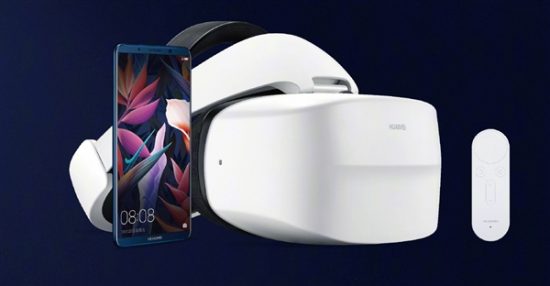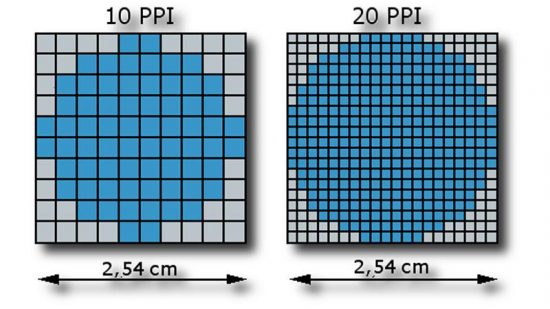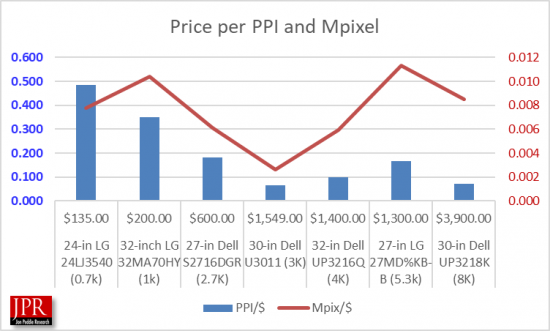Alternate facts or hidden value?
Remember, the more you can see, the more you can do? Well when HD monitors rolled on the scene that axiom started to catch the imagination of users, and their managers (“gee, do MORE, for just the cost of a monitor, hell yeah”).
The higher the K to dollar ratio, the better the deal. Monitor suppliers are under marketing their products and the value of their monitors. See more, do more for less dollars.
HD resolution is referred to as “1K” because it is 1080 lines, the consumer electronics market doesn’t worry over much about exact math, and round-off can be as high as ±10%. Therefore, 4K is 4× the total resolution of a 1K HD display. The numbers look like this.

A 4K monitor turns out to be 400% more than total resolution than an HD or 1K monitor, but an 8K is 16 times more. The K’ness of a monitor is arrived at by the ratio of HD lines.
![]() or
or ![]()
The equations works for anything above HD.
Using lines to define the K of a monitor sells it short, and in some cases over sells it.
Recently Huawei introduced a VR HMD with 1600 pixels/line, and 1440 lines, per eye. That was described as 3K.

A 3K screen would have one and a half times the lines of an HD screen, or 1620 lines, so Huawai’s VR HMD is actually 2.22K.
However, assuming one keeps the same aspect ratio as an HD display, i.e., 16:9, then the resolution of a 3K screen would be 3326 pixels/line, and 1871 lines. So, there’s no way the Huawei HMD could be considered 3K.
LG introduced a monitor, the $1,300 UltraFine 5K, with 5120 × 2880 resolution. It complies to the 16:9 aspect ratio, but if you do the math, it has 14.7 Mpix, which is 7.1 × HD, so LG is offering a 7K monitor and under marketing it at 5K. Apple also offers the monitor, as a 5K.

A 5K monitor, with 16:9 aspect ratio, would have 4293 × 2415 resolution, 10.368 Mpix. But, if you use lines and the above equation you get 5.3K.
Dell offers the UP2715K, a $699, 27-inch monitor they market as a 5K. It offers two resolution modes, 5120 × 2880 at 60 Hz (dual DP cable required) and 3840 × 2160 at 60 Hz (single DP cable required).

The actual resolutions are 4K and 7K, no 5K to be found. Dell also offers a real 8K monitor, the 32-inch, $3,900 UP3218K.

An 8K monitor has 16 times the resolution of an HD monitor, 33 Mpixels, but doesn’t cost 16 times as much—the value of a monitor goes up with the Ks.
The other subject affecting the seeing more:doing more ratio is the measurement of pixels per inch (some folks prefer the term “dots,” a left over from the printing industry). Pixels per inch (PPI) is a way of thinking about jaggies. If the number is too low, you don’t get nice non-orthogonal lines.

When the first serious word processor monitors and laser printers came to the market, 72-PPI was the norm, and anything above that was considered high resolution, or high quality. PPI is primarily a horizontal number, although some have expressed it as an average of height × width as well. It involves the aspect ratio, and physical size of the monitor. I generated a little table to show some comparisons:

If you compare monitors by Mpixels/dollar, you can see the best value. You can also compare by PPI/dollar which factors in the physical size of the monitor.

Obviously an 8K monitor will give you the most PPI (see last column, table above). However, a 5K monitor will give you the best Mpixels/dollar, and pretty good PPI/dollar. Over time, the 8K monitors will drop in price and offer the best PPI and Mpixels/dollar. But here atop Mt Tiburon, it’s all about Megapixels—can’t have too many.





